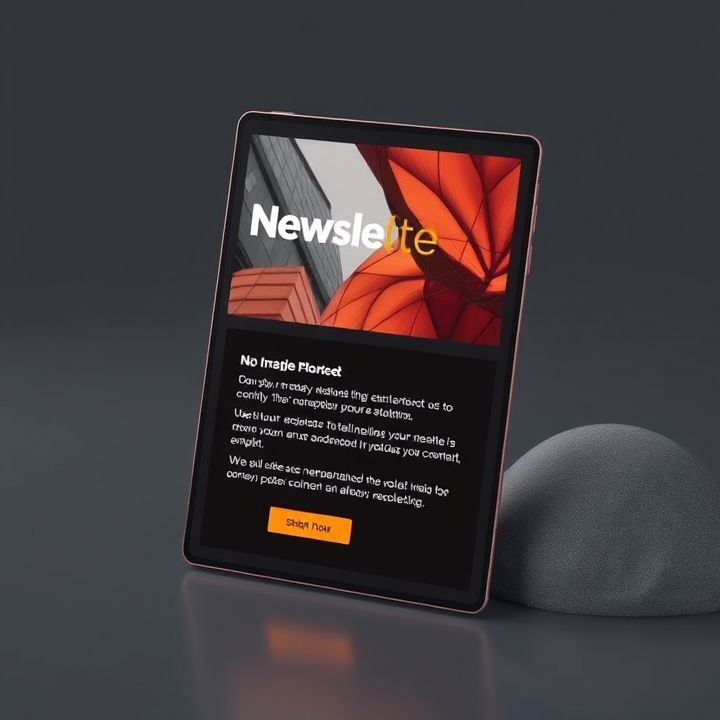Table of Contents
- Introduction
- Choosing High-Quality Images That Reflect Your Brand
- Ensuring Media Is Mobile-Friendly for Wider Reach
- Balancing Image Size and Quality for Quick Load Times
- Using Alt Text to Improve Accessibility and SEO
- Leveraging Videos and GIFs to Enhance Engagement
- Conclusion
- Frequently Asked Questions
Introduction
Are you ready to transform your email marketing strategy from mundane to magnificent? Imagine if each email you sent captured hearts and fired up engagement like never before. In the realm of digital marketing, where every click and open counts, the secret sauce might just be a dash of visual magic. Dive into our treasure trove of image and media hacks designed to turn your emails into veritable engagement magnets!
But first, feast your eyes on an engaging visual:
We’ll take you on a journey through the power of visuals, as illustrated below:
| Strategy | Impact |
|---|---|
| Compelling Visuals | Increase open rates by 30% |
| GIF Animations | Boost click-through by 45% |
| Infographics | Enhance content retention by 60% |
Ready to delve deeper into the visual revolution that’s reshaping email engagement? Let’s unravel these hacks and unleash the full potential of your email campaigns!
Choosing High-Quality Images That Reflect Your Brand
Choosing high-quality images that reflect your brand is crucial for enhancing the visual appeal of your emails. Images are not just fillers; they convey messages, evoke emotions, and enhance brand recognition. Start by selecting images that align with your brand’s identity, ensuring that the colors, themes, and style are consistent with your overall branding strategy. High-resolution images are imperative, as they portray professionalism and attention to detail. Blurry or pixelated visuals can detract from the credibility of your content.
Consider using custom images or stock photos that have not been overused in your industry to maintain originality. Furthermore, images should emotionally resonate with your target audience, helping them connect more deeply with your brand. Including people in your visuals can enhance relatability, while abstract designs can express creativity and innovation.
Lastly, ensure images are optimized for fast loading times to prevent any disruptions in user experience. Employing formats like JPEG or PNG and compressing images without losing quality can improve performance.
Ensuring Media Is Mobile-Friendly for Wider Reach
In today’s digital landscape, ensuring media is mobile-friendly is crucial for reaching a broader audience. With a significant number of users accessing emails on their smartphones and tablets, optimizing images and media for mobile devices can enhance user engagement and improve visibility. One effective strategy is to use responsive design techniques, ensuring that images and videos adapt seamlessly to different screen sizes. This can be achieved by using scalable vector graphics (SVG) for images, which maintain quality at any size, and implementing CSS media queries to adjust layouts.
Keeping file sizes small is also important for mobile optimization as it reduces load times, especially for users with slower internet connections. Compressing images without sacrificing quality and choosing appropriate formats, such as JPEG for photos and PNG for graphics with transparent backgrounds, can help achieve this. Additionally, using lazy loading techniques allows media to load only when visible on the screen, improving performance and user experience.
Furthermore, providing alternative text for images ensures accessibility and enhances search engine optimization (SEO). It also guarantees information is conveyed even if the image fails to load. By implementing these practices, you can effectively optimize the use of media in emails to maximize impact while ensuring a wider reach across mobile users.
Balancing Image Size and Quality for Quick Load Times
In the realm of email marketing, optimizing image size and quality is pivotal for ensuring quick load times and maintaining user engagement. Large images can significantly slow down email load times, leading to poor user experience and potentially causing recipients to abandon the email altogether. On the other hand, low-quality images may fail to captivate your audience or convey the intended message effectively.
To strike the ideal balance, consider using image compression tools that can significantly reduce file sizes without compromising on quality. Selecting the right image format is also crucial; JPEGs are typically preferred for photographs due to their capability to maintain quality at smaller file sizes, while PNGs are suitable for graphics that require transparency. Additionally, leveraging scalable vector graphics (SVGs) can be beneficial for logos and icons.
Another key strategy is to determine the optimal dimensions for your images based on where they’ll appear in the email layout. This minimizes unnecessary data as recipients won’t need to load larger images than necessary. Lastly, by preloading images for critical elements or thumbnails, you can enhance user experience by reducing perceived load times.
Using Alt Text to Improve Accessibility and SEO
Using alt text effectively in your emails can significantly enhance accessibility and improve SEO performance. Alt text, short for alternative text, is the written description that appears in place of an image if the image fails to load on a user’s screen. This text is vital for ensuring that individuals using screen readers can understand the content of your images, making your emails accessible to a wider audience, including those with visual impairments. When crafting alt text, ensure it’s concise and descriptive, capturing the essence of the image without redundancies.
Moreover, alt text can boost your email’s SEO. Search engines crawl through alt text to comprehend the image content, influencing how your email content is indexed and displayed in search results. By incorporating relevant keywords naturally within your alt text, you can improve the discoverability of your emails, thereby maximizing the impact of your digital campaigns. However, avoid keyword stuffing as it could negatively affect both user experience and your SEO ranking. Instead, focus on crisp, informative descriptions that align with the overall context of your email message. Implementing these strategies will significantly enhance both the functionality and reach of your email communications.
Leveraging Videos and GIFs to Enhance Engagement
Incorporating videos and GIFs into your email marketing strategy can significantly boost engagement and enhance the overall impact of your messages. Videos capture attention quickly and can convey complex information in an easily digestible format. By embedding or linking to a video in your email, you can offer recipients a dynamic experience that can drive better click-through rates and foster a deeper connection with your content. However, it’s crucial to ensure that your videos are optimized for fast loading times and are compatible with different devices and email clients.
GIFs, on the other hand, offer a fun and captivating way to demonstrate products, capture emotions, or highlight key points. They tend to be smaller in file size compared to videos, making them ideal for quick storytelling within emails without drastically affecting loading times. To maximize their impact, consider using GIFs to emphasize call-to-action buttons or to add life to an otherwise static layout.
When using videos and GIFs, always include alternative text and captions to improve accessibility. Additionally, test your emails across various platforms to ensure that these media elements function seamlessly, providing an engaging and inclusive experience for every recipient.
Conclusion
As we wrap up our exploration of image and media strategies for email marketing, it’s clear that visual elements play a critical role in boosting engagement. Adopting high-quality images that reflect your brand identity, optimizing these media for mobile devices, and ensuring quick load times through proper format selection are essential steps towards enhancing user experience. By integrating alt text, not only do you cater to accessibility needs, but you also enhance SEO performance, making your emails more discoverable. Furthermore, the use of videos and GIFs introduces a dynamic component that can captivate your audience and drive interaction.
Ultimately, the secret to skyrocketing email engagement lies in the careful balance of creativity and technical understanding. By employing the hacks discussed, such as responsive design and lazy loading, you position your email campaigns for success across all platforms. Remember, the key is not just in what you communicate, but also in how you present it. Continually test and refine your strategies to keep your audience engaged and your brand top-of-mind in their inbox.

